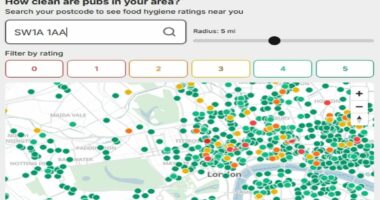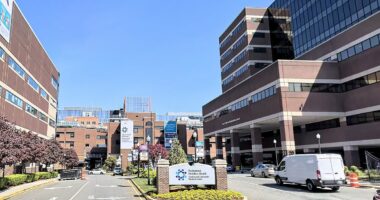Share this @internewscast.com
In a striking revelation, almost 10% of Americans claim to have been diagnosed with cancer, according to a recent survey. This figure marks the highest percentage ever recorded in the United States.
The latest findings from Gallup indicate that 9.7% of U.S. adults reported having received a cancer diagnosis at some point in their lives. These results stem from surveys conducted between 2024 and 2025.
This represents a notable increase from the prior survey period in 2022 and 2023, where 8.9% of participants reported a cancer diagnosis. The data also shows a significant rise of nearly 40% since the survey’s inception in 2008-2009, when only 7% of respondents had been diagnosed with cancer.
However, experts at Gallup have advised caution in interpreting these numbers. The increase does not necessarily indicate a rise in cancer rates among the general population. Instead, it may reflect demographic shifts within the surveyed population.
While estimates suggest an overall increase in the number of new cancer cases in the U.S., this is attributed to the growing population. Consequently, the incidence rate—expressed as the number of new cases per 100,000 people—has remained relatively stable.
The total number of new cancer cases is rising in the US, estimates suggest, but because the population is also rising, the rate, or number of new cases per 100,000 people, has remained broadly similar.
Researchers said the US now has more cancer survivors than ever because the population contains more older adults, who are more likely to be diagnosed with cancer, and because survival rates have vastly improved.
The American Cancer Society estimates that cancer mortality has declined 34 percent from 1991 to 2022, reflecting an improvement in treatments and screening techniques, leading to more cases being detected earlier when they are easier to treat.
According to the CDC, the rate of new cancer diagnoses actually fell four percent between 2013 and 2022.
Researchers also noted, however, an uptick in cancers, including breast and colon cancer, among younger adults, which is driving a new concerning trend.
A study recently showed that 14 cancers in under-50s are rising, while experts say patients in this group have a higher fatality rate because they are more likely to be diagnosed at the later stages, when they are much harder to treat.
Doctors have been raising the alarm over rising cancer rates among young adults for years, although the causes are not clear, and they’ve blamed everything from more sedentary lifestyles and poor diet to toxins and ultra-processed foods.
For the poll, Gallup conducted telephone interviews with a nationally-representative sample of 30,000 adults across all 50 states and Washington DC from February to September 2025.
To determine whether participants had received a cancer diagnosis, the team asked: ‘Has a doctor or nurse ever told you that you have cancer?’
Overall, over the 15 years since the survey began, older Americans have shown the fastest rise in the proportion who have been diagnosed with cancer.
Among people over 65, 21.5 percent now say they have received a cancer diagnosis, up 3.4 percent compared to the 2008 to 2009 period.
Among those aged 45 to 64 years old, 8.9 percent now say they have received a cancer diagnosis, up 1.5 percent compared to the same period.
Meanwhile, among those aged 18 to 44, the survey found the proportion who have received a cancer diagnosis remained steady since 2008 to 2009, when the survey began.
Gallup researchers did not say why rates remained steady in the younger age group, but this may have been because the survey sample size was too small to detect any significant increase in the group.
Overall, men were more likely to say they had received a cancer diagnosis than women. A total of 9.8 percent of men said they had received the diagnosis in the latest survey, compared to 9.6 percent of women.
Among men, the proportion saying they had received a diagnosis was up 3.6 percent over the 15-year period, compared to up 1.7 percent among women.

Shown above is Monica, who did not give her last name, who was diagnosed with stage 4 colon cancer last year at the age of 31 years old
By ethnic group, Black adults saw the fastest increase in the proportion saying they had been diagnosed with cancer, a rise of 3.6 percent overall.
They were followed by white adults, who had a 2.7 percent uptick, and Hispanic adults, who had a 2.3 percent rise.
At the other end of the scale, Asian adults saw the slowest growth in the proportion who said they had received a cancer diagnosis, up 1.4 percent over the 15-year period.
Overall, white adults were most likely to receive a cancer diagnosis, the survey suggested, at 10.9 percent saying they had been told they had cancer.
The diagnosis was least likely among Asian adults overall. The survey showed 3.2 percent said they had previously received a cancer diagnosis. Among black adults, it was 7.8 percent, and among Hispanic adults, it was 5.4 percent.
Gallup experts said: ‘Overall, the cancer story in the US is mixed with both good news and bad news.
‘Mortality is falling and people are living longer post-diagnosis, but an aging population and an increasing percentage of those living post-removal or post-remission bring their own challenges to the US healthcare system.
‘Even after being clinically cancer-free, survivors typically remain under structured medical surveillance for years, and sometimes indefinitely, depending on the cancer type, stage and treatment history.
‘The result is that even as millions of Americans are no longer acutely ill, they remain medically engaged, seeing oncologists or other specialists, undergoing scans, managing late effects and living with ongoing health anxiety.’














